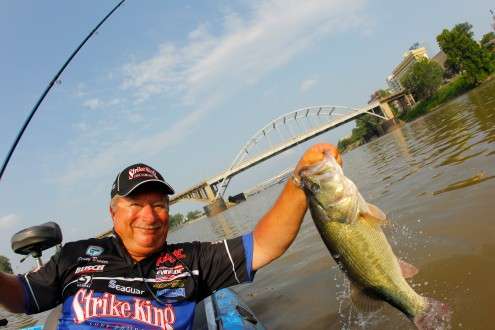
As fall marches towards winter across the country, things change for flippers and pitchers. You'll remember from Lesson 12 that we have several options in the early fall, for both baits and locations.
Now, as the water cools, we have fewer of both. That doesn't mean all is lost, however. It isn't. It's a matter of changing your thinking. You can still fish the backs of the creeks and the cuts, but the flat side of the lake is out of the picture. And, even in the creeks and cuts, we have to adjust our strategy. Instead of attacking the heavy cover areas along the bank, we need to think more about vertical spots. The bass will move from the banks towards hard channel swings, ledges, drops and deep holes as the water turns cold. In much of the country they'll still be relatively shallow — mostly less than 15 feet — but they'll be relating to vertical structure rather than horizontal cover.
I get a little bullheaded at this time of the year when it comes to lure selection. (Some of you who know me might say I'm bullheaded most of the time, but that's a subject for another day.) I want a Strike King Denny Brauer Premier Pro-Model Jig with a Strike King Denny Brauer Chunk for a trailer. I'm not interested in other plastic baits such as creature baits, tubes or worms.
The reason for this is simple: I don't want my bait to have much action. To me, that's only common sense. As the water drops below 65 degrees and on towards the lower 50-degree range, everything in the lake or river slows down. Anything with a lot of movement will look unnatural and won't generate very many bites.
At the same time that everything's slowing down, there's less runoff coming into the lake or river. That means the water is clearing. In fact this is the time when it's at its clearest in many bodies of water. That's why I like natural-colored jigs and trailers for the late fall and early winter. Something in brown, green, watermelon or green pumpkin will usually produce best. Avoid flashy, bright colors.
When I'm fishing less than 15 feet deep, I'll almost always go with a 3/8-ounce jig. That's heavy enough to work with but still gives me the option to work it around and into sunken cover and heavy brush on the edges of sharp, vertical drops. I get a little bit of both worlds with that size. Below 15 feet, I'll upsize to a 1/2-ounce model. The extra weight allows me to get to the bottom quickly, and at that depth, that's what most of the fish are relating to anyway. They aren't likely to be suspended in anything, including open water.
Regardless of my depth, however, I slow down. Late season fish don't want something moving fast or that acts lively. I rarely hop it at all. I drag it along slowly, and then slower still as the water gets colder. An occasional two or three second pause won't hurt a thing. Proper jig movement is as much an art as it is a science. You have to experiment and try different movements until you find what works. And remember, what works in one creek in the morning may not work in another creek later in the day. You have to adapt to your venue and your fish.





